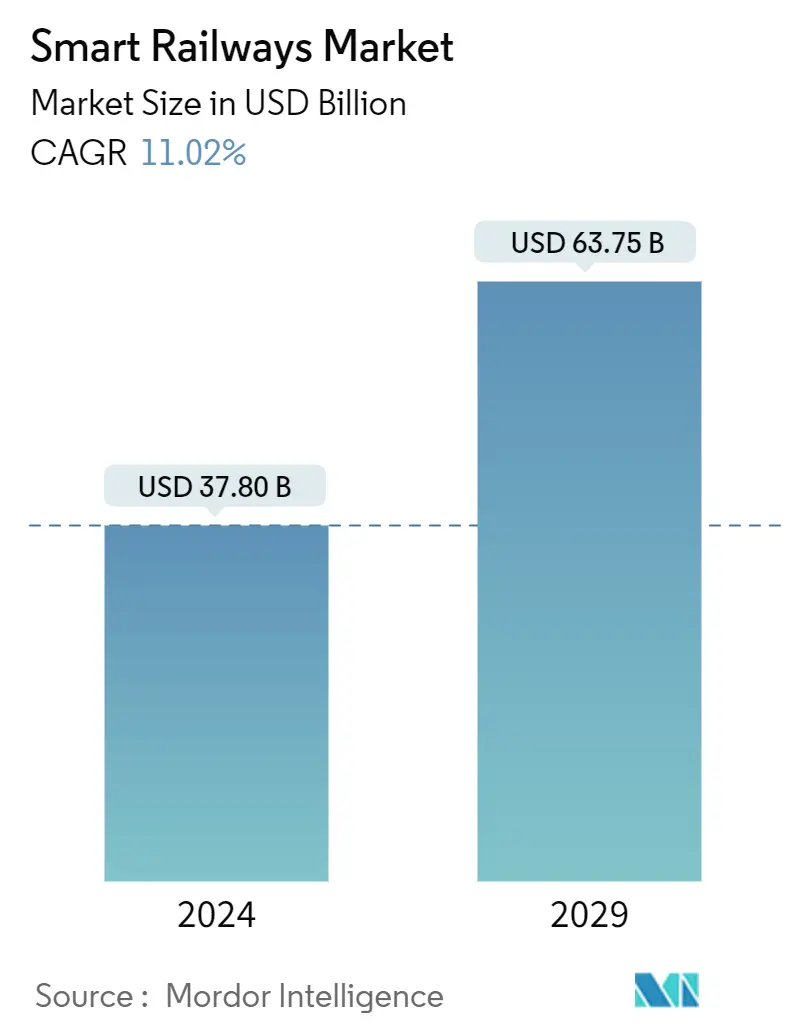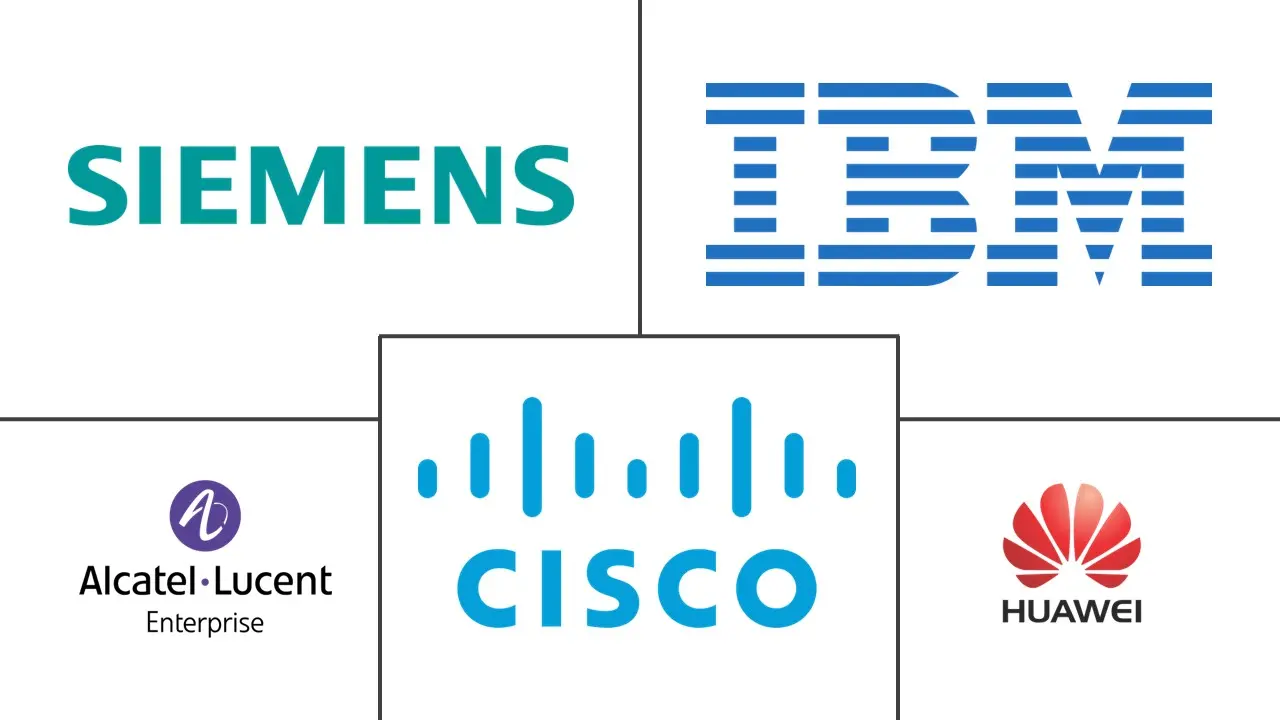Market Size of Smart Railways Industry

| Study Period | 2019 - 2029 |
| Market Size (2024) | USD 37.80 Billion |
| Market Size (2029) | USD 63.75 Billion |
| CAGR (2024 - 2029) | 11.02 % |
| Fastest Growing Market | Asia Pacific |
| Largest Market | Europe |
| Market Concentration | Low |
Major Players
*Disclaimer: Major Players sorted in no particular order |
Smart Railways Market Analysis
The Smart Railways Market size is estimated at USD 37.80 billion in 2024, and is expected to reach USD 63.75 billion by 2029, growing at a CAGR of 11.02% during the forecast period (2024-2029).
- The adoption of new technology-based solutions to enhance the operation of train services by leveraging real-time data is driving market growth, creating demand for smart solutions such as analytics systems for various applications. For instance, Indian Railways opted for the Internet of Things (IoT) to enhance the operation of train services. The Real-Time Train Information System (RTIS), which uses GPS sensors mounted on locomotives to monitor the exact location of trains in real time, is implemented.
- The initiatives taken by several country governments for the modernization of stations and adoption of technology are further adding growth to the market. These initiatives are driving the need for solutions such as passenger information systems, smart ticketing systems, energy management systems, analytics platforms, and others that help enhance overall passenger experience and convenience, increasing overall efficiency.
- Moreover, the adoption of artificial intelligence (AI) and the Internet of Things (IoT) for various applications is expected to encourage vendors to launch solutions based on these technologies, as railway authorities in multiple countries are emphasizing the adoption of advanced technology.
- One of the major obstacles faced by the legacy railway systems is their aging infrastructure. A broad array of railway networks have been in operation for decades, and their outdated design, as well as the technology involved within it, hinder their energy efficiency. Upgrading these systems requires a significant investment of time and resources, posing a challenge to the market studied.
- In the post-pandemic scenario, the market outlook was positively impacted by rising demand for biometric, integrated, contactless, and mobile payment adoption systems, sensor-based technology, and ticketing technologies at railway stations with increased modernization activities.
Smart Railways Industry Segmentation
The term smart railway refers to a technologically enhanced strategy for managing railway operations that involves sharing rail data among rail infrastructure components such as control centers, passengers, freight, and ticketing departments. Smart railways are the integration of advanced technologies such as Big Data, the Internet of Things (IoT), analytics, cloud, global positioning system (GPS), AI, and ML to enhance the efficiency and accuracy of rail operations.
The smart railways market is segmented by solution (rail analytics system, railway communication and networking system, freight information system, smart ticketing system, advanced security monitoring system, passenger information system, and other solutions) and geography (North America, Europe, Asia-Pacific, Latin America, Middle East and Africa). The market size and forecasts are provided in terms of value (USD) for all the above segments.
| By Solution | |
| Rail Analytics System | |
| Railway Communication and Networking System | |
| Freight Information System | |
| Smart Ticketing System | |
| Advanced Security Monitoring System | |
| Passenger Information System | |
| Other Solutions |
| By Geography | |
| North America | |
| Europe | |
| Asia-Pacific | |
| Latin America | |
| Middle East and Africa |
Smart Railways Market Size Summary
The smart railways market is poised for substantial growth, driven by the integration of advanced technologies such as the Internet of Things (IoT) and artificial intelligence (AI) to enhance train operations and passenger experiences. The market is witnessing a surge in demand for smart solutions, including analytics systems, passenger information systems, and smart ticketing systems, as governments worldwide invest in railway modernization and technology adoption. These initiatives aim to improve operational efficiency, safety, and passenger convenience, addressing challenges posed by aging infrastructure. The post-pandemic recovery has further accelerated the adoption of contactless and mobile payment systems, contributing to the market's positive outlook.
In the Asia-Pacific region, the smart railways market is experiencing rapid expansion due to significant investments in infrastructure and technology upgrades. The region's focus on smart ticketing and security monitoring systems is enhancing operational efficiency and passenger safety. China's extensive railway infrastructure development, supported by substantial capital investment, is a key driver of demand for innovative communication and networking systems. Major players in the market, such as Cisco Systems Inc., IBM Corporation, and Huawei Technologies Co. Ltd, are leveraging partnerships and technological advancements to strengthen their market position. The introduction of new products and solutions, like Siemens Mobility's electric Mireo Smart train and Huawei's next-generation railway mobile communications system, underscores the industry's commitment to sustainable and efficient rail transport solutions.
Smart Railways Market Size - Table of Contents
-
1. MARKET INSIGHTS
-
1.1 Market Overview
-
1.2 Industry Attractiveness - Porter's Five Forces Analysis
-
1.2.1 Threat of New Entrants
-
1.2.2 Bargaining Power of Buyers
-
1.2.3 Bargaining Power of Suppliers
-
1.2.4 Threat of Substitutes
-
1.2.5 Intensity of Competitive Rivalry
-
-
1.3 Impact of Macroeconomic Trends on the Market
-
1.4 Value Chain Analysis
-
-
2. MARKET SEGMENTATION
-
2.1 By Solution
-
2.1.1 Rail Analytics System
-
2.1.2 Railway Communication and Networking System
-
2.1.3 Freight Information System
-
2.1.4 Smart Ticketing System
-
2.1.5 Advanced Security Monitoring System
-
2.1.6 Passenger Information System
-
2.1.7 Other Solutions
-
-
2.2 By Geography
-
2.2.1 North America
-
2.2.2 Europe
-
2.2.3 Asia-Pacific
-
2.2.4 Latin America
-
2.2.5 Middle East and Africa
-
-
Smart Railways Market Size FAQs
How big is the Smart Railways Market?
The Smart Railways Market size is expected to reach USD 37.80 billion in 2024 and grow at a CAGR of 11.02% to reach USD 63.75 billion by 2029.
What is the current Smart Railways Market size?
In 2024, the Smart Railways Market size is expected to reach USD 37.80 billion.

